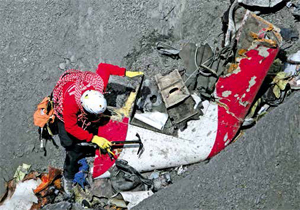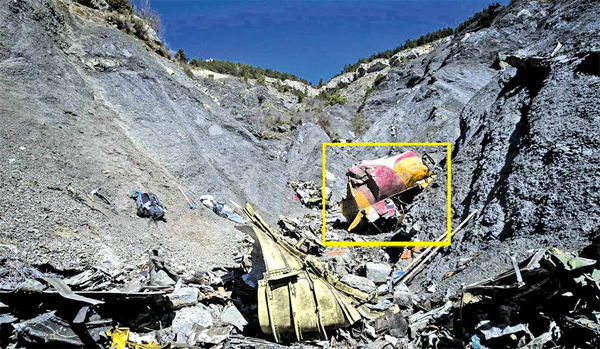|
However, for safety reasons i.e. to prevent a forced entry into the cockpit using
the pilot outside as a hostage, the pilot inside the cockpit can lock the door
from inside thus deactivating the keypad outside. According to Lufthansa Group
CEO, Carsten Spohr, “The co-pilot, according to the audio recordings, took advantage
of the momentary absence of the commander from the cockpit and then prevented
him from coming back into the cockpit.” As can be expected, there has been a spurt
of reactive actions by airlines and regulatory authorities – mostly related to
cockpit procedures – to prevent recurrence. However, some more profound cogitation
is required by civil aviation community to delve deeper into the causative and
preventive facets of the accident.  Cockpit
As A Fortress Cockpit
As A Fortress
Although the cockpit door of an airliner has always been
an inhibiting barrier between the cockpit and the cabin; l’affaire 9/11 provided
the impetus to turn the cockpit into a small citadel. Cockpit doors were strengthened
considerably, provision was made for the cockpit crew to lock the door from the
inside, and changes were made to ensure that entry from outside was intricate
and extremely challenging if the cockpit occupants contested it. Ironically, these
very factors facilitated the Germanwings accident. Once Lubitz had locked his
captain out, an entry into the cockpit could not be forced within the time available
up to the impact with ground. The fortress design of the cockpit was validated
by the accident but 150 lives were lost in the bargain. As can be expected
there has been a spurt of announcements from all over the world declaring the
presence of two crew members in the cockpit mandatory at all times in flight.
US FAA already requires airlines to have a flight attendant or a relief pilot
to replace a pilot who leaves the cockpit during a flight for any reason. That
policy is now being quickly adopted by many airlines globally. Aviation regulators
in Europe and Canada were the first to embrace the policy within 24 hours of the
crash. The European Aviation Safety Agency (EASA ) has issued a temporary recommendation
(not mandatory yet) proposing that two crew members, including at least one qualified
pilot, should occupy the cockpit during flight. Germanwings parent company Lufthansa
Group announced it is implementing the policy. The Canadian Government said it
would mandate a similar policy for Canada’s airlines. Air France- KLM has said
it would implement the EASA recommendation as soon as possible. Some others which
announced changes to this effect almost immediately after the reasons for the
crash became evident are Air Malta, Lithuania’s Air Lituanica, Berlinbased Germania,
EasyJet, Norwegian Air Shuttle, Air Canada and Air Transat, Virgin Australia,
Swiss International Air Lines, Emirates Airlines and Etihad Airways. India has
had the two-crewin- cockpit rule since 2010 although the rationale for the Indian
regulation was not the one applicable to the Germanwings accident. Instead, India
implemented it because of an incident wherein the co-pilot, alone in the cockpit
with the captain outside, encountered an autopilot problem and was not up to the
situation. The flight rapidly descended through 7,000 feet in the two minutes
it took for the captain to key in the security code on the keypad outside the
cockpit door, enter the cockpit, and regain control of the aircraft. However,
these actions need to be seen against the backdrop of the probability of recurrence.
Since 1994, there have been only four accidents (a Royal Air Maroc ATR 42 in 1994,
a Silk Air Boeing 737 in 1997, an EgyptAir Boeing 767 in 1999 and a Linhas Aereas
de Mocambique (LA M) Embraer 190 in November 2013) in which the most likely cause
was intentional action by a pilot. While mandating two crew members in the cockpit
during flight is a practical solution, any attempts to render the cockpit more
accessible in the face of resistance from within the cockpit would be a retrograde
step. The question here is whether technology has any other solutions to offer. 
Technology
to the Rescue Technology has made considerable progress in aerospace as
well as information technology. Can it offer some means to foolproof aircraft
cockpits against intentional actions by a pilot on the controls? The degree of
automation in the actual flying of an aircraft is already at extraordinary levels;
indeed there is a debate on as to whether such a high level of automation (with
pilots’ hands on intervention in a modern airliner reduced to take off and landing
phases only) is a good thing for aviation safety. The leading edge of technology
offers the wherewithal to snatch command of an aircraft from the hands of a pilot
to save it from impending flight into terrain below. NASA , USA F and Lockheed
Martin have designed an Automatic Ground Collision Avoidance System (Auto-GCAS
) for the F-16 while SAB has produced a similar system for JAS 39 Grippen. These
systems constantly compute the aircraft trajectory visa- vis the terrain below
and provide warning when an impending impact is indicated. If no action is initiated
by the pilot, the Auto-GCAS takes over control from the pilot until the aircraft’s
return to safety. Technologically, it is therefore possible to provide such a
system in the cockpit which could have prevented the Germanwings crash. The
phenomenal evolution of unmanned aerial systems is another avenue to explore.
Unmanned and optionally piloted aircraft are already a reality in the military
domain. The technology available to remotely fly unmanned aircraft permits an
arrangement wherein there is one pilot in the cockpit and another on the ground.
Although current design and development has as its objective a safeguard against
a situation wherein the on-board pilot becomes incapacitated so that the ground
station can assume control and fly the aircraft like an unmanned one, it could
be tweaked to design protocols which permit a takeover by the ground pilot in
case of any trouble in the cockpit. A variation of this design could be a human
pilot and a robotic system sharing the cockpit and a set of rules that permit
the robotic system to take over controls overruling the human pilot. All the critical
controls required for a safe recovery could be designed in such a way that the
pilot inputs are through a computer interface thus permitting a ground station
to override pilot inputs through satellite data links. Indeed, Honeywell obtained
a patent in 2009 for a flight system that could take control of a plane's cockpit
controls and remotely pilot a commercial plane to prevent "unauthorised flight".
Needless to say, very highly sophisticated Artificial Intelligence levels would
be required to achieve this model with assured safety levels. So what about
a totally unmanned airliner? Again, technology exists to make that possible. However,
pilots’ unions would oppose such a proposal tooth and nail while associated increase
in insurance premia can be expected to render the idea unaffordable. The cost
of the technology itself might become a restraining factor. Moreover, the average
air traveller might find the idea of boarding a commercial flight with an unmanned
cockpit intimidating; after all, being a human he can be expected to place more
faith in a human than in a computer despite any empirical data indicating otherwise.
The reader might like to ask himself whether he would like to be on an aircraft
from his favourite airline the first time it offered a pilotless flight.
It will be some years when the right balance between technology, social acceptance,
and acceptable checks and balances are in place to permit any of the above options,
especially unmanned commercial flights (may be the start could be with cargo carrying
commercial flights). Technology is a good handmaiden when it comes to finding
solutions to new problems but can have its own costs. Finally, there is always
the challenge of protecting any computer based system from mala fide hacking.
Human Factors In the near future, a cockpit
devoid of human presence appears hard to imagine. In any case, as some argue,
even an unmanned cockpit would be controlled by a ‘human’ element from the ground.
Thus, human factors would continue to pose a challenge to the aviation industry
howsoever, technology might endeavour to render flight safe. The pilot’s behaviour
will always remain a cause for trepidation and a potential for accidents. After
this accident, media is reporting EASA ’s concerns about Germany’s infirmities
in the area of air safety, especially on crew health monitoring. For its part,
Luftfahrt-Bundesamt (LBA), the German aviation authority, has stated that Lufthansa,
the parent company for Lubitz did not inform it about his previously known history
of suicidal tendencies and severe depression. It appears that Lubitz had informed
Lufthansa in 2009 that he had suffered from severe depression. Although declared
fit, he was still undergoing treatment from neurologists and psychiatrists and
the concerned doctors had occasionally declared him sick (he was declared sick
on the day of the crash as well). Carsten Spohr, (Group CEO Lufthansa) has reportedly
stated that the airline was not aware of any health issues regarding Lubitz's
fitness to fly, calling him "100 per cent airworthy". India has been prompt to
heed the problem of mental health and has begun a process to regulate new norms
for mental health including regular check ups. Psychometric tests could
soon complement the routine physical checks carried out for pilots every six months
(Psychometry deals with the design, administration, and interpretation of quantitative
tests for the measurement of psychological variables such as intelligence, aptitude,
and personality traits). Conclusion In the
aftermath of the Germanwings accident, some cynics have averred that despite any
amount of technological innovations, operational regulation and air safety initiatives,
accidents cannot be eliminated. Against the backdrop of this accident, the campaigners
for the intelligent cockpit assert that computers are not prone to mental health
disorders and suicidal tendencies. The human element is pointed out as the weakest
element in the safety environment. The civil aviation community eagerly waits
to see if and when unmanned commercial passenger carriers would ply routinely.
Meanwhile, there is optimism that psychometric testing of pilots (for mental instability,
depression and other oddities of behaviour) would reduce the probability of accidents
of the Germanwings variety. |